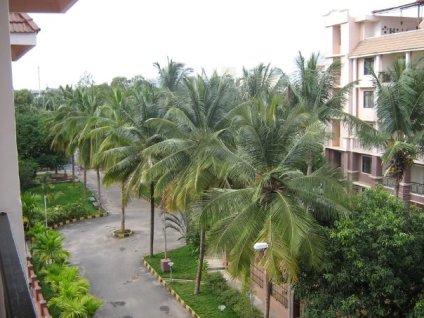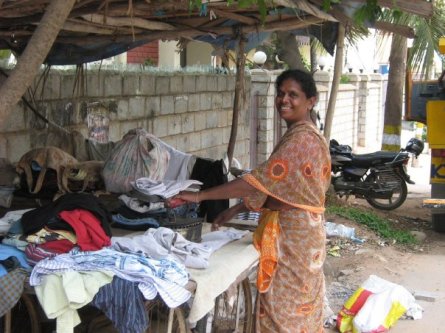Since my day spent, in part, with the street people of Toronto, I have been reflecting back to other poverty I have witnessed in my travels.
In Alabama, I saw the folks who lived in the “little pink houses” of which John Mellencamp wrote in his song “Little Pink Houses (for you and me)”, but those folks, although at or below the poverty line, are not the ones that stick in my mind. What comes to mind in the southern U.S. are the government trailer parks with line after line of dingy white trailers housed with multiple families (mostly African American) situated on dusty dirt behind chain link fences, as if incarcerated. Their children ran barefoot and often pantsless (whether by choice or not I can’t say – it was brutally hot, and I know I like to be pantsless at home!) The elderly sat on upturned buckets or ratty lawn chairs keeping watch on the shrieking shenanigans of bare butt children and frenzied dogs, leaping after them. Occasionally, a scarfed grandma would be seen sweeping the ground at the foot of the trailer door, in a never ending attempt to clean away the grime and dust.
I’d never seen poor like that before. Oh wait – yes, yes I had!
In more northern climes, in my own country, many years ago as a youth, I remember travelling through a couple of Indian Reserves. It reminds me of the Wizard of Oz movie, when it starts off black and white and suddenly changes to techni-colour, only this was the other way around. My travels through started off in full vibrant colour and gradually faded into black and white the deeper I got into the Res.
The houses became more dilapidated until every house I saw was no more than wood pieces hammered together. Some were old trailers with extensions built from cardboard, steel and wood. I could see no options for indoor plumbing, electricity, or phones. I kept thinking where do they keep their food if they don’t have electricity for a fridge? It never entered my head I should be thinking “what food?”. I was so young at the time, the reality escaped me.
Did you know that even today, in 2019, just over 600 First Nation communities in Canada and “at any given time one in five of these communities are under a boil water advisory.” What? they have to boil their water prior to consumption? In Canada, in 2019?? What the actual fuck, peeps!
And did you know some of these Reserves are mere minutes away from your neighbourhood? How is it possible you have potable water and half hour from you a whole community does not? How is it possible this has not been addressed by our Canadian standards? Potable water is a RIGHT as laid down in 2010 by the United Nations General Assembly. This is Canada, ffs! How can some people not have clean drinking water?
Then, many years later, I travelled to India for work for six weeks. Yes, India! Me! I know! I am actually so happy I went, now, although at the time I was fraught with every anxiety under the sun (and more, I was also living with dickhead at the time). There I saw a different kind of poverty.

this was situated next to the building in my neighbourhood
It was the same, but different.
I mean, poor is poor right? You’d think…
Firstly, I soon figured out you could tell have’s from have not’s by their shoes – or lack thereof. Those with money had shoes; the poor had bare feet. It didn’t matter whether they were working or beggars, if they were poor, they went everywhere in bare feet. Even to work. Even if their job was construction, chopping wood, climbing scaffolds, whatever. Unless you were required to wear a uniform for your job, if you were poor, you had bare feet.
I saw construction workers on scaffolds four or five stories high, painting, hammering, and they had no tie offs, no hard hats, no shoes. The scaffold was pieced together bamboo hand-tied with rope, perilously propped against the walls, not the fancy schmancy metal poles with locking mechanisms we have here. I saw construction workers digging foundations for huge mega-apartments side by side with back-hoes, with no shoes, no hard hats, and using sticks and hand-tied shovels to dig.
It was an insurance claim waiting to happen. But guess what, they didn’t have insurance either! If someone lost a foot, or fell off a scaffold and could no longer work, they became beggars. I saw one beggar with his arm broken in three places, healed incorrectly, and he showed us that was his reason for begging, and not working. He had no shoes. He was a beggar but he looked exactly like the working poor there. Hmmm.

this was upscale, but it was right next to the shanties pictured above
The homes these folks lived in were built of corrugated metal, and pieces of wood, propped up against a million-dollar condominium side by side. On the same street. The juxtaposition amazed me. Here, we have “areas” of town which evolve into luxury, middle class, and poor. There, rich and poor was side by side. There were no “poor” areas. They were mixed together like curry-flavoured Bits-and-Bites.
So you could walk down the street, visit shops, see gorgeous hotels, and then come upon a smattering of muddy hovels, with sari-strewn electrical lines, women making paratha, a high-class mall, a skyscraper tech company, and a line of bodegas with dirt floors and stray dogs. Then there might be a Hindu temple, with flowing palm trees and brightly dressed ladies in saris, sweeping the ground around it with tea leaves, bent over double, and not wearing shoes.

this lady did the laundry for my apartment building. it was all done under this shanty outside the property on the street
And they smiled. Always. I would walk by and they would gesture for me to take their picture, with big smiles, they would pose in front of their street sweeper or temple or while they were ironing the clothing of the guests at the hotel across the road. They smiled.
They got their water from a local reservoir. It was not drinkable for us, but that is what they used for cooking, drinking, bathing, and washing. They had to carry it in buckets and bowls. Sometimes they balanced the jars of water on their heads and walked. I kid you not. Just like in the movies.
But whenever I asked to take a picture, they smiled, with or without teeth. It was lovely. It made me really happy to take their picture, like I was doing them a favour. I thought about this a lot, afterwards.
Why wouldn’t they be sad? Disgruntled? Jealous? I mean, right next door was a beautiful pink condo, obviously filled with people wearing shoes. I think somehow, even though they knew they were poor, even though they could see wealthy folks beside them, it never entered their head that there was anything wrong with the status quo. That it could, and maybe should, be different. It was just accepted as how it was, and they seemed happy. One of my colleagues told me it was because they knew people who were worse off and they were just happy not to be in that pickle.
I don’t know. I don’t have an explanation for it. I just know whenever I felt anxious, or down while I was there, I went for a walk and took pictures, and this always cheered me up.
When I left, I left a few pairs of my shoes in my apartment for anyone who needed them.
They were crocs. I don’t think they minded. 🙂
